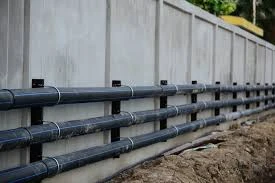Oct . 22, 2024 06:46 Back to list
welding rods for pvc
Welding Rods for PVC A Comprehensive Guide
Welding rods for PVC (polyvinyl chloride) play a crucial role in various applications, from construction to manufacturing. PVC is one of the most commonly used plastics in the world, thanks to its versatility, durability, and cost-effectiveness. However, when it comes to joining PVC materials, the right welding rod is essential to ensure strong, reliable, and long-lasting bonds.
Understanding PVC Welding
PVC welding is a process that involves melting the surfaces of PVC materials and allowing them to fuse together. This technique is widely used in plumbing, electrical conduits, signage, and various industrial applications. The main methods of welding PVC include hot air welding, extrusion welding, and ultrasonic welding. Regardless of the method used, the choice of welding rod is critical for the success of the welding process.
Types of Welding Rods for PVC
When selecting welding rods for PVC, it's important to consider the specific type of PVC being used, as there are different formulations that may require distinct welding rods. Generally, the most common types of welding rods for PVC include
1. Homopolymer PVC Rods These rods are made from homopolymer PVC, which is the most common type of PVC material. They are suitable for welding applications involving standard PVC sheets and pipes.
2. Chlorinated PVC (CPVC) Rods CPVC is a variation of PVC that is chlorinated, allowing it to withstand higher temperatures. CPVC welding rods are ideal for plumbing applications that require resistance to hot water.
3. PVC Blend Rods These rods combine PVC with other materials to enhance certain properties. They are often used in specialized applications where additional flexibility or impact resistance is required.
Factors to Consider
When choosing welding rods for PVC, several factors should be taken into account to ensure optimal results
welding rods for pvc

- Compatibility Ensure that the welding rod is compatible with the specific type of PVC being welded. Using an incompatible rod can lead to weak joints and even failure.
- Application Consider the intended application of the welded joint. For instance, joints exposed to higher temperatures or pressure will require more robust welding rods.
- Thickness of Materials The thickness of the PVC materials being welded will influence the choice of welding rod. Thicker materials may require a higher deposition rate from the welding rod.
Proper Welding Techniques
To achieve strong and durable welds, proper welding techniques must be employed. Here are some key tips
- Surface Preparation Clean the surfaces to be welded thoroughly to remove any dirt, dust, or grease. This ensures that the weld has a clean bonding surface.
- Welding Temperature Maintain the appropriate welding temperature for the PVC material being used. This is crucial for achieving good fusion without burning or degrading the material.
- Speed and Pressure Control the speed and pressure of the welding process. Moving too fast may result in weak joints, while too much pressure can distort the materials.
Conclusion
In conclusion, the selection of the right welding rods for PVC is integral to ensuring the quality and durability of welded joints. By understanding the different types of rods available and considering the specific requirements of your project, you can achieve optimal results in your PVC welding applications. Whether you're involved in plumbing, manufacturing, or construction, choosing the right welding rod will ultimately lead to successful and reliable outcomes in your work.
-
PVC Transparent Sheet Roll - Durable & Flexible PVC Plastic Sheet Roll for Industrial & Home Use
NewsJun.24,2025
-
High-Quality PVC PPR Pipes and Fittings Durable ERA PPR Solutions
NewsJun.10,2025
-
High-Quality Large HDPE Sheets & Large Diameter PVC Pipe Durable Large PVC Pipe Supplier
NewsJun.10,2025
-
High Density Polyethylene Cutting Board - Durable & Food Safe
NewsJun.09,2025
-
3 Inch PVC Pipe for Durable Irrigation Affordable & Reliable
NewsJun.09,2025
-
Premium PPR Plastic Water Pipe Fittings - Durable & Leak-Free
NewsJun.09,2025

